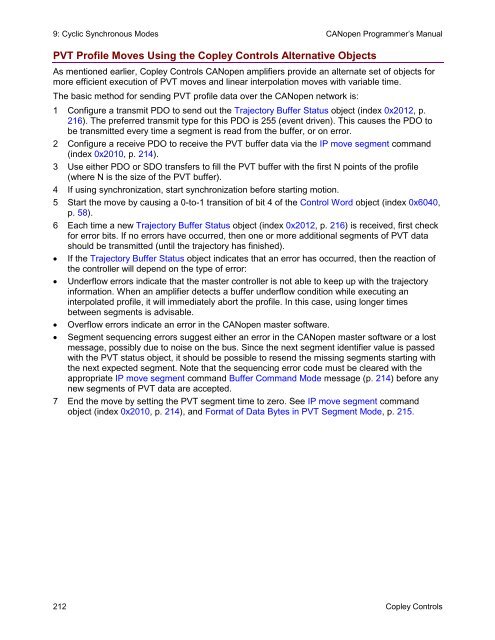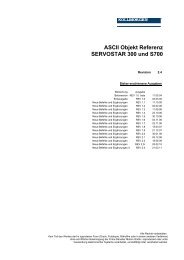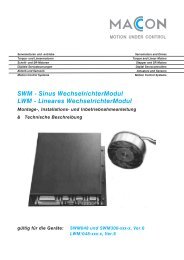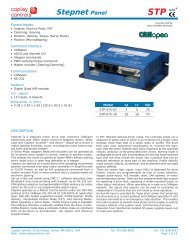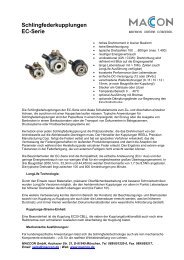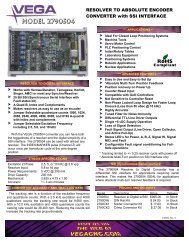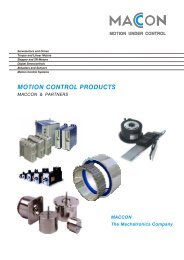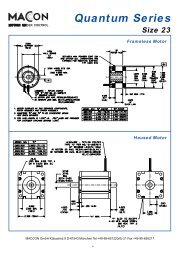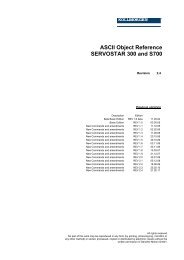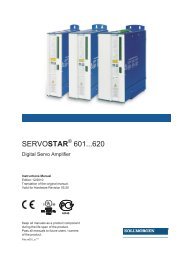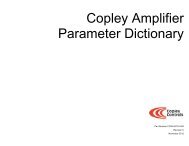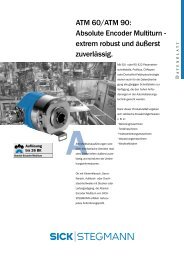CANopen Programmer's Manual - Maccon.de
CANopen Programmer's Manual - Maccon.de
CANopen Programmer's Manual - Maccon.de
Create successful ePaper yourself
Turn your PDF publications into a flip-book with our unique Google optimized e-Paper software.
9: Cyclic Synchronous Mo<strong>de</strong>s <strong>CANopen</strong> Programmer’s <strong>Manual</strong><br />
PVT Profile Moves Using the Copley Controls Alternative Objects<br />
As mentioned earlier, Copley Controls <strong>CANopen</strong> amplifiers provi<strong>de</strong> an alternate set of objects for<br />
more efficient execution of PVT moves and linear interpolation moves with variable time.<br />
The basic method for sending PVT profile data over the <strong>CANopen</strong> network is:<br />
1 Configure a transmit PDO to send out the Trajectory Buffer Status object (in<strong>de</strong>x 0x2012, p.<br />
216). The preferred transmit type for this PDO is 255 (event driven). This causes the PDO to<br />
be transmitted every time a segment is read from the buffer, or on error.<br />
2 Configure a receive PDO to receive the PVT buffer data via the IP move segment command<br />
(in<strong>de</strong>x 0x2010, p. 214).<br />
3 Use either PDO or SDO transfers to fill the PVT buffer with the first N points of the profile<br />
(where N is the size of the PVT buffer).<br />
4 If using synchronization, start synchronization before starting motion.<br />
5 Start the move by causing a 0-to-1 transition of bit 4 of the Control Word object (in<strong>de</strong>x 0x6040,<br />
p. 58).<br />
6 Each time a new Trajectory Buffer Status object (in<strong>de</strong>x 0x2012, p. 216) is received, first check<br />
for error bits. If no errors have occurred, then one or more additional segments of PVT data<br />
should be transmitted (until the trajectory has finished).<br />
If the Trajectory Buffer Status object indicates that an error has occurred, then the reaction of<br />
the controller will <strong>de</strong>pend on the type of error:<br />
Un<strong>de</strong>rflow errors indicate that the master controller is not able to keep up with the trajectory<br />
information. When an amplifier <strong>de</strong>tects a buffer un<strong>de</strong>rflow condition while executing an<br />
interpolated profile, it will immediately abort the profile. In this case, using longer times<br />
between segments is advisable.<br />
Overflow errors indicate an error in the <strong>CANopen</strong> master software.<br />
Segment sequencing errors suggest either an error in the <strong>CANopen</strong> master software or a lost<br />
message, possibly due to noise on the bus. Since the next segment i<strong>de</strong>ntifier value is passed<br />
with the PVT status object, it should be possible to resend the missing segments starting with<br />
the next expected segment. Note that the sequencing error co<strong>de</strong> must be cleared with the<br />
appropriate IP move segment command Buffer Command Mo<strong>de</strong> message (p. 214) before any<br />
new segments of PVT data are accepted.<br />
7 End the move by setting the PVT segment time to zero. See IP move segment command<br />
object (in<strong>de</strong>x 0x2010, p. 214), and Format of Data Bytes in PVT Segment Mo<strong>de</strong>, p. 215.<br />
212 Copley Controls


